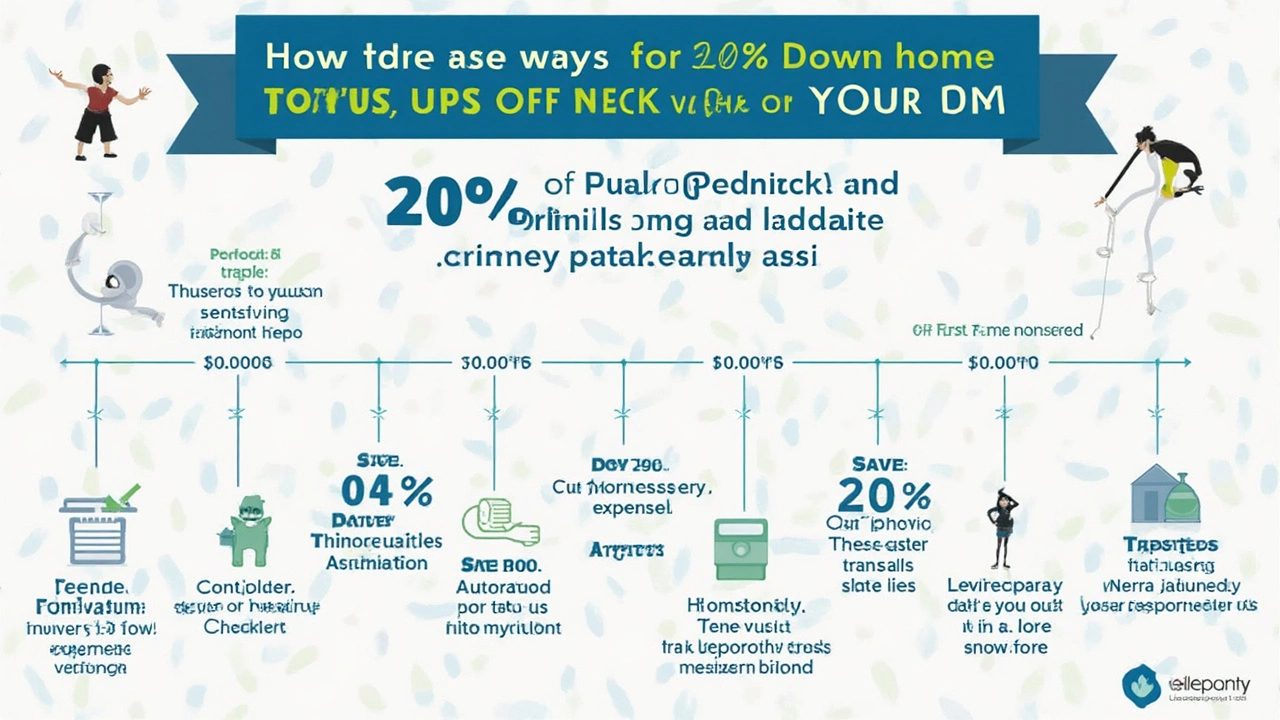Understanding the 20% Down Payment on a $300,000 House
 Feb, 7 2025
Feb, 7 2025
Trying to buy your first home and wondering how much 20% is on a $300,000 house? You're not alone. The simple math: 20% of $300,000 is $60,000. Yep, that’s quite a chunk of change! But why 20%? Well, putting down this amount can help avoid private mortgage insurance (PMI) and might even give you a leg up with better loan terms.
Now, you might be thinking, paying $60,000 upfront sounds a bit steep. Don’t panic. There are ways to make it more manageable. For example, if you’re struggling to scrape that together, there are programs out there designed for folks just like you—first-time homebuyers who need a little help. Plus, we’ll explore some clever strategies to help you save up that sum faster.
Getting to grips with this part of the home-buying journey is crucial. With a solid plan and a bit of savvy, saving up 20% could be less daunting than it seems. Let’s make dreams of having your very own place a reality, with fewer headaches along the way.
- Understanding the Down Payment
- Why 20%?
- Exploring Your Options
- Creative Ways to Save
- Deciding Your Next Steps
Understanding the Down Payment
If you're stepping into the world of buying your first home, the term 'down payment' might sound a bit intimidating. In simple terms, a down payment is the initial amount you pay upfront when purchasing a house. For a $300,000 house, a down payment of 20% comes to about $60,000.
Why is it important? Well, making a hefty down payment can actually work in your favor. By putting down 20%, you typically avoid something called private mortgage insurance (PMI). This is a fee lenders charge to protect themselves when you're borrowing more than 80% of the home's value. So, saving yourself from this could mean fewer monthly expenses.
How Does It Affect Your Loan?
The down payment directly influences your mortgage terms. A higher down payment often translates to a lower interest rate and smaller loan payments each month—less money paid in the long run. Plus, it builds immediate equity in your home.
Exploring Alternatives
Can't hit that 20% mark? Don't worry. Some loans allow smaller down payments. FHA loans, for example, cater to first-time homebuyers with as little as 3.5% down, though PMI will likely be required until you reach 20% equity. Evaluate your financial situation and see what works best for you.
Understanding how the down payment fits into the home-buying puzzle is key. It’s usually the biggest upfront cost in a real estate purchase. Yet, knowing your options can help you save significantly as you journey toward owning your first home.
Why 20%?
The idea of a 20% down payment isn't pulled out of thin air—it's got some serious backing. Mortgage lenders often ask for it because it's that sweet spot where you're less risky in their eyes. Why? Because it shows you’re committed and have some skin in the game. Plus, with this amount down, lenders are more likely to offer you better terms.
At 20%, you avoid that extra cost called private mortgage insurance (PMI). What's PMI, anyway? Basically, it's insurance lenders make you pay if your down payment is less than 20%. They’re covering themselves if you can’t make your payments. So, hitting that 20% mark saves you money in the long run, as PMI can add a few hundred bucks to your monthly costs.
Benefits of 20% Down
- Lower Interest Rates: Lenders see you as a lower risk, which could mean securing a better rate on your mortgage.
- Equity Boost: Starting with more equity in your home isn't just about bragging rights—it can provide a cushion if the market wobbles.
- More Purchasing Power: Having a sizable down payment often means you'll qualify for a bigger mortgage, giving you more housing options.
Some folks might hesitate at this number, but if you’ve got the means, it can be a smart strategy. Think of it this way: you’re investing in both your home and your financial future.

Exploring Your Options
When you're thinking about making a 20% down payment on a $300,000 house, it's good to know you have options. Not everyone has $60,000 saved up, and that's okay. Let's break down some choices you might consider.
Mortgage Assistance Programs
First up, check out mortgage assistance programs. These are geared towards first-time homebuyers like you who need a little help. Many states offer down payment assistance, sometimes in the form of grants or low-interest loans. The goal is to lighten the financial load so you can step into homeownership with more confidence.
FHA Loans
If you don't have 20% for a down payment, an FHA loan can be a lifesaver. With these loans, you could pay as little as 3.5% down, which might sound like music to your ears. Just keep in mind that with less down, you'll likely pay PMI, which will increase your monthly payments.
VA and USDA Loans
For those who qualify, VA loans and USDA loans are incredible deals with no down payment required. VA loans are for veterans and active service members, while USDA loans are for homes in rural areas. Both options can significantly ease the upfront cost of buying a home.
Getting Creative
Sometimes you have to think outside the box. Maybe you have access to retirement savings or a gifting relative. Tapping into a 401(k) or receiving a family member's monetary gift are avenues some folks choose to explore. Just make sure to consider any penalties or tax implications first.
Looking at the Numbers
To give you some perspective, here’s a quick glance at potential down payment amounts based on different scenarios:
| Loan Type | Down Payment |
|---|---|
| 20% | $60,000 |
| FHA (3.5%) | $10,500 |
| VA/USDA (0%) | $0 |
Whatever option you choose, the goal is to fit your budget and future plans. Take your time, weigh these options, and move forward with confidence towards making that house your home.
Creative Ways to Save
Saving up for a down payment can feel like an uphill climb. But with a bit of creativity, it's possible to reach that goal quicker than you might think.
Automate Your Savings
Setting up automatic transfers from your checking account to your saving account is like putting your savings on autopilot. Choose a realistic amount and schedule it to transfer on payday, or whenever suits your income flow. That way, you won’t even notice the money leaving your account, but your savings will steadily grow.
Side Hustle Your Way There
In today’s gig economy, picking up a side hustle is easier than ever. You could freelance with skills you already have, like graphic design or copywriting. Or, you might consider driving for a rideshare company or pet sitting through apps like Rover. Redirecting the extra income from these gigs directly into your down payment fund can be a huge boost.
Utilize High-Yield Savings Accounts
If you’re keeping your savings in a regular account, you might be missing out on free money. Look into high-yield savings accounts that often offer higher interest rates. Your money will work harder for you just by sitting there.
Cut Back Where You Can
Small daily savings can add up over time. Think about skipping that daily coffee shop visit and make coffee at home instead. Reevaluate your gym membership if it’s gathering dust. Being mindful and curbing some non-essential spending can free up some funds for your down payment goal.
Get Creative With Gifts
Got a birthday or holiday coming up? Let your loved ones know that contributions towards your homebuying fund would be the best gift. Even small contributions can pile up, getting you closer to that dream home.
Consider Employer Programs
Some employers offer programs to help employees save for a home. It’s not super common, but it’s worth checking with your HR department to see if there’s any assistance available.
Track Your Progress
Regularly check in on your progress. Keeping an eye on your growing savings can provide motivation to stick to your goal. Little wins along the way can make cutting back and hustling feel worthwhile.
By utilizing these creative strategies, securing your first-time homebuyer's dream doesn't have to remain just a dream. Get started today, and you'll be amazed at how quickly your efforts accumulate into that sought-after 20% down payment!

Deciding Your Next Steps
Alright, you've got the numbers straight and a few strategies under your belt, but what's the next move in your first-time homebuyer journey? Let's break it down to actionable steps.
Evaluate Your Financial Standing
First, take a good look at your current financial situation. Do you have debts that need clearing? Are your savings in good shape? If not, you might want to spend a few months getting those in order. After all, a solid financial foundation is key to securing a great mortgage rate.
Set a Realistic Timeline
Rome wasn’t built in a day, and neither will your savings account for that 20% down payment. Start by setting a realistic timeline for when you can save up the amount needed. Think about how much you can put aside each month without skimping on essentials. Remember, slow and steady wins the race.
Research the Housing Market
Keeping an eye on the housing market trends is a smart move. Prices can fluctuate, and understanding where they might go will help you decide when to buy. Chat with local real estate agents, read market reports, and stay informed.
Explore Mortgage Options
Not all mortgage plans are created equal. Check out different lenders to see what terms they offer. Some might provide options that suit your financial habits, such as fixed-rate or adjustable-rate mortgages.
Here’s a quick comparison of two common options:
| Mortgage Type | Interest Rate | Monthly Payment |
|---|---|---|
| Fixed-Rate | 3.5% | $1,347 |
| Adjustable-Rate | 3.0% initially | $1,264 initially |
Consider Professional Guidance
If navigating the whole home-buying process feels a bit overwhelming, don’t hesitate to reach out to a financial advisor or a mortgage broker. Their expertise could be the nudge you need to make informed decisions.
Ultimately, being clear about your goals and resources will guide you towards the right choices. With patience and planning, moving into your own space isn’t just a dream—it's within reach. And who knows? That charming little place with the white picket fence could soon be yours.